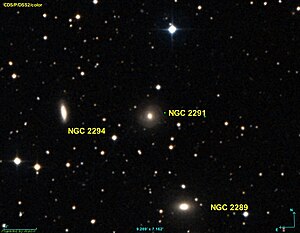NGC 2291
| Galaxy NGC 2291 |
|
|---|---|

|
|
| AladinLite | |
| Constellation | Twins |
|
Position equinox : J2000.0 , epoch : J2000.0 |
|
| Right ascension | 06 h 50 m 58.6 s |
| declination | + 33 ° 31 ′ 30 ″ |
| Appearance | |
| Morphological type | SA0 ^ 0 ^ |
| Brightness (visual) | 13.2 mag |
| Brightness (B-band) | 14.2 mag |
| Angular expansion | 1 ′ × 0.8 ′ |
| Position angle | 126 ° |
| Surface brightness | 12.8 mag / arcmin² |
| Physical data | |
| Redshift | 0.017362 ± 0.000120 |
| Radial velocity | (5205 ± 36) km / s |
|
Stroke distance v rad / H 0 |
(232 ± 16) x 10 6 ly (71.1 ± 5.0) Mpc |
| history | |
| discovery | John Herschel |
| Discovery date | January 22, 1827 |
| Catalog names | |
| NGC 2291 • PGC 19719 • CGCG 175-020 • MCG + 06-15-013 • 2MASX J06505858 + 3331305 • LDCE 0468 NED010 | |
NGC 2291 is a lenticular galaxy of the Hubble type S0 in the constellation Gemini on the ecliptic . It is an estimated 232 million light years from the Milky Way .
The object was discovered by John Herschel on January 22nd, 1827 .
